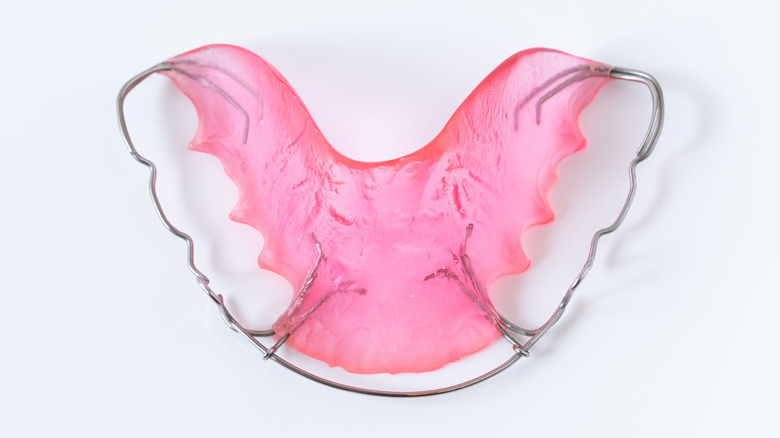This Is What Happens To Your Teeth When You Stop Wearing A Retainer
The day your dentist says you can finally remove your braces is cause for celebration. While it may seem like your teeth-straightening journey is over and done with, dentists advise on the importance of follow-up care and the use of a retainer.
While there are different types of retainers, they all serve the same purpose — keeping teeth firmly in place. According to Ricci Orthodontics, this apparatus is intended to be worn consistently in the months following the initial removal of braces or an Invisalign device. Some types of retainers are "fixed," meaning they are permanently adhered to the teeth for a number of weeks and are often worn before transitioning to a removable retainer. On the positive side, they're easily concealed, so no one would know you're wearing a dental device. On the other hand, fixed retainers can sometimes cause some level of discomfort. A removable retainer utilizes plastic and wire to create a mold unique to the wearer's mouth. While long-lasting, this device, unlike a fixed retainer, is more visible to others.
While missing a day or two of wearing your retainer may not sound like a big deal, miss too many days, and you may be unraveling all previous progress made.
How long do you need to wear your retainer for?
Our teeth are creatures of habit. Meaning, once they've established their natural positioning, without the use of corrective equipment, they'll attempt to return to their initial state (via South Springs Dental Group). Our teeth's natural tendency to shift and move is known as "mesial drift." To keep teeth aligned, a retainer works as a barricade which prevents that movement. When we neglect to wear our retainer regularly, there is nothing stopping our teeth from gradually returning to their prior state.
Does this mean we need to wear a retainer 24 hours, 7 days a week, forever and ever? Not quite. According to South Springs Dental Group, the shifting of our teeth slows with age. While still moving, the frequency with which we need to wear a retainer will also begin to slow. For removable retainers, the first three to six months post-braces will require these retainers to be worn for at least 22 hours out of the day, with the exception of while eating or brushing teeth. For the next two years, retainer-wearing can be downgraded to part-time hours — meaning, only at nighttime. From the third year on, retainer usage can be even further reduced, though only slightly. Rather than popping in your retainer every night before bedtime, wearing your retainer every other night will give your mouth a break from the device, while effectively still keeping your new smile in place.


